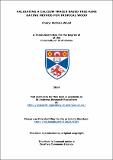Files in this item
Validating a calcium tracer based tree-ring dating method for tropical wood
Item metadata
| dc.contributor.advisor | Wilson, Rob | |
| dc.contributor.author | Wood, Cheryl Victoria | |
| dc.coverage.spatial | xviii, 280 | en_US |
| dc.date.accessioned | 2015-03-27T11:59:38Z | |
| dc.date.available | 2015-03-27T11:59:38Z | |
| dc.date.issued | 2014-04-04 | |
| dc.identifier | uk.bl.ethos.644821 | |
| dc.identifier.uri | https://hdl.handle.net/10023/6389 | |
| dc.description.abstract | The tropics are a key part of the global biosphere. Specifically, the woodland environments not only moderate large scale climate dynamics, but are also crucial in the global carbon cycle. Despite this, tropical dendrochronological studies are rare due to the uncertainty in annual dating from the minimal seasonality in most tropic environments. Without distinct annual tree rings, dendrochronological dating methods do not work, therefore other dating methods are required before long term forest growth analyses can be made. Alternatives such as radiocarbon and stable isotope measurements can be expensive and require high resolution measurement in order to identify seasonality. This thesis introduces a novel dating method for tropical trees using calcium as a tracer of annual wood formation. Laser Ablation-ICP-MS provides a fast, high resolution method for measuring mineral elements which could potentially provide a solution to the dating of tropical trees. Initially, Scots pine provided an excellent testing species for the development of both the methodological and analytical dating methods proposed through this thesis. It’s well defined, annually dated ring structure formed the basis of seasonal signal detection and the development of an objective analysis for dating. This was achieved by the continuous measurement of calcium, and utilising a threshold detection approach to define annual growth cycles with respect to extreme peaks in the tracer data-series. The initial success of the calcium dating method using pine allowed for testing the technique on a tropical trees species from Cameroon which lacks distinct rings. Along with radiocarbon dating, the robustness of the calcium dating method for this tropical species was assessed. Promising results were initially found however, these could not be replicated and validation of this method proved problematic. Finally, radiocarbon dates were used to assess the nature of the oxygen and carbon stable isotopic series from the single tree of the same species from the tropical calcium tests. Results showed that despite the clear cyclic signal present in the oxygen isotope record, this did not represent an annual signal. These results reinforce the problems associated with tropical dendro analysis. | en_US |
| dc.language.iso | en | en_US |
| dc.publisher | University of St Andrews | en |
| dc.rights | Creative Commons Attribution-NonCommercial 4.0 International | |
| dc.rights.uri | http://creativecommons.org/licenses/by-nc/4.0/ | |
| dc.subject | Dendrochronology | en_US |
| dc.subject | Dendrochemistry | en_US |
| dc.subject | Calcium | en_US |
| dc.subject | Tropics | en_US |
| dc.subject | Trees | en_US |
| dc.subject.lcc | QK477.2A6W7 | |
| dc.subject.lcsh | Dendrochronology | en_US |
| dc.subject.lcsh | Tree-rings | en_US |
| dc.subject.lcsh | Trees--Age determination--Tropics | en_US |
| dc.subject.lcsh | Trees--Tropics | en_US |
| dc.title | Validating a calcium tracer based tree-ring dating method for tropical wood | en_US |
| dc.type | Thesis | en_US |
| dc.contributor.sponsor | Scottish Alliance for Geoscience, Environment and Society (SAGES) | en_US |
| dc.type.qualificationlevel | Doctoral | en_US |
| dc.type.qualificationname | PhD Doctor of Philosophy | en_US |
| dc.publisher.institution | The University of St Andrews | en_US |
This item appears in the following Collection(s)
Except where otherwise noted within the work, this item's licence for re-use is described as Creative Commons Attribution-NonCommercial 4.0 International
Items in the St Andrews Research Repository are protected by copyright, with all rights reserved, unless otherwise indicated.


